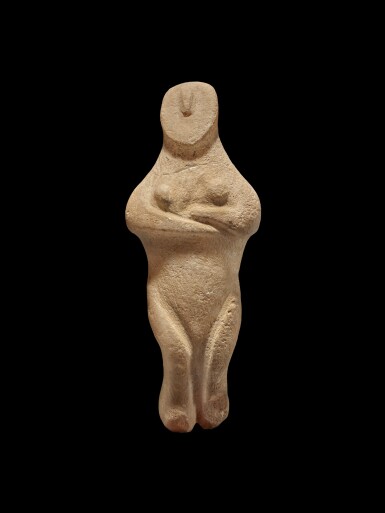CYCLADIC MARBLE FIGURE OF A GODDESS, EARLY CYCLADIC II PERIOD (KEROS-SYROS CULTURE) Modeled with arms folded beneath her breasts on ebonized wood stand. 5 x 1 3/4 in. Provenance: Zoumboulakis, Athens, Greece in the late 1950's/early 1960's; The collection of Arthur Jacobs, New York; thence by decent to Gabriel Jacobs, Shaw Island, Washington; the collection of Arthur L. Jacobs. Note: Early Cycladic figurines are the most important works of Cycladic art. They usually represent standing naked (or nude) female figures whose ancient prototypes are Neolithic female figurines from the Greek mainland, from Aegea, and Anatolia. Nearly all are made of marble, and are of varying sizes. They are thought to be representations of goddesses, or of the Great Mother, other theories suggest that they are apotropaic figures, or representations of nymphs or heroes, or revered ancestors, even divine nursemaids. There are three recognizable stylistic periods. Early Cycladic II period (Keros-Seros culture, 2800-2300 BCE): Typical Early Cycladic II period figurines are standing with the arms folded at the waist and the head somewhat tilted back (the heads are frequently lost). The legs are usually bent-slightly-at the knees, and in most cases the feet (where present) are inclined as if the figure was standing on tiptoe. Facial features and body parts are usually shown three-dimensionally, or incised, and, sometimes, painted. Several varieties of the folded arm type can be distinguished based on differences in the outline or the modeling of the body. These are the Kapsala, Spedos, Dokathismata, and Chalandriani varieties, named for the cemeteries of Amorgos, Naxos and Syros, where these varieties were first found. Schematic type figurines were also made during the Early Cycladic II period characterized by quadrangular outline and a rough indication of a head-the feature that distinguishes these schematic type figurines from those of the Early Cycladic I period. Some figurines from the Early Cycladic II period are fully three-dimensional and quite large, reaching a height up to four-and-one-half feet (1.5m). The best examples are of musicians: seated or standing male figures playing musical instruments. In this flourishing period of Cycladic sculpture (and Cycladic civilization in general) there is a broad diffusion of figurines throughout the Aegean through export and local manufacture. Our thanks to Glenn A. Long, former Curator-in-Charge of African, Oceanic, Pre-Columbian and American Indian Art, The Baltimore Museum of Art for his research.
CYCLADIC MARBLE FIGURE OF A GODDESS, EARLY CYCLADIC II PERIOD (KEROS-SYROS CULTURE) Modeled with arms folded beneath her breasts on ebonized wood stand. 5 x 1 3/4 in. Provenance: Zoumboulakis, Athens, Greece in the late 1950's/early 1960's; The collection of Arthur Jacobs, New York; thence by decent to Gabriel Jacobs, Shaw Island, Washington; the collection of Arthur L. Jacobs. Note: Early Cycladic figurines are the most important works of Cycladic art. They usually represent standing naked (or nude) female figures whose ancient prototypes are Neolithic female figurines from the Greek mainland, from Aegea, and Anatolia. Nearly all are made of marble, and are of varying sizes. They are thought to be representations of goddesses, or of the Great Mother, other theories suggest that they are apotropaic figures, or representations of nymphs or heroes, or revered ancestors, even divine nursemaids. There are three recognizable stylistic periods. Early Cycladic II period (Keros-Seros culture, 2800-2300 BCE): Typical Early Cycladic II period figurines are standing with the arms folded at the waist and the head somewhat tilted back (the heads are frequently lost). The legs are usually bent-slightly-at the knees, and in most cases the feet (where present) are inclined as if the figure was standing on tiptoe. Facial features and body parts are usually shown three-dimensionally, or incised, and, sometimes, painted. Several varieties of the folded arm type can be distinguished based on differences in the outline or the modeling of the body. These are the Kapsala, Spedos, Dokathismata, and Chalandriani varieties, named for the cemeteries of Amorgos, Naxos and Syros, where these varieties were first found. Schematic type figurines were also made during the Early Cycladic II period characterized by quadrangular outline and a rough indication of a head-the feature that distinguishes these schematic type figurines from those of the Early Cycladic I period. Some figurines from the Early Cycladic II period are fully three-dimensional and quite large, reaching a height up to four-and-one-half feet (1.5m). The best examples are of musicians: seated or standing male figures playing musical instruments. In this flourishing period of Cycladic sculpture (and Cycladic civilization in general) there is a broad diffusion of figurines throughout the Aegean through export and local manufacture. Our thanks to Glenn A. Long, former Curator-in-Charge of African, Oceanic, Pre-Columbian and American Indian Art, The Baltimore Museum of Art for his research.









Testen Sie LotSearch und seine Premium-Features 7 Tage - ohne Kosten!
Lassen Sie sich automatisch über neue Objekte in kommenden Auktionen benachrichtigen.
Suchauftrag anlegen